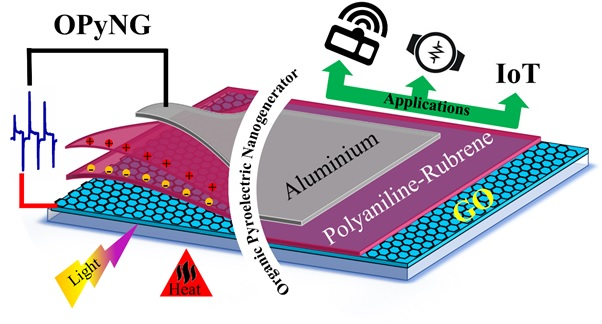A new nanogenerator device developed for harvesting light energy using organic material has the potential to power wearable devices on the go. The device can generate current and voltage from minute amounts of heat or light that fall on it.
The scientific community has been making ceaseless efforts to meet the ever-growing energy demand. Harnessing energy from the nano regime is a prime focus, and exploring energy generation from organic materials is highly useful for sustainability.
Scientists at the Institute of Advanced Study in Science and Technology (IASST), an autonomous institute of the Department of Science and Technology (DST), Govt. of India, have developed a nanogenerator device for harvesting light energy using organic material, which has the potential to power wearable devices on the go. The device can generate current and voltage from minute amounts of heat or light that fall on it.
The experimental exploration of energy materials by the team at IASST has led to the successful synthesis of an organic energy material called polyaniline-rubrene, and they have fabricated an Organic Pyroelectric Nanogenerator (OPyNG). This work has recently been published in the journal Nano Energy.
The device features an architectural design, as depicted in the accompanying figure, with polycrystalline graphene oxide and polyaniline-rubrene forming a rectifying junction. In this configuration, the polyaniline-rubrene thin film serves as the photoactive layer responsible for generating charge carriers. The pyroelectric effect of the device is induced by the light-induced change in spontaneous polarization occurring in the ultra-thin oxidized surface layer of the polyaniline-rubrene thin film. The working principle of the device is based on the pyro-phototronic effect. This effect holds a unique advantage in the pyroelectric nanogenerator (PyNG), as it can optically induce the pyroelectric effect, which is useful for energy harvesting.
The fabricated OPyNG device utilizing organic material provides new insights and opens up new avenues for harvesting energy from organic materials. The OPyNG operates in the UV-visible-NIR region in self-powered mode, and it offers significant advantages as it can function as a self-sustainable standalone device.
The fabricated device demonstrates the highest output at a wavelength of 405-450 nm, with responsivity of 167.12 mA/W, external quantum efficiency of 51.16%, and internal quantum efficiency of 63.59%. Additionally, the device exhibits a voltage generation of approximately 157.75 mV and a volume power density of about 51 mW/cm3. These achievements are commendable, especially considering the small area of the device, which is only 1 cm2. Furthermore, the device boasts a fast response time of a few tens of milliseconds. Given these characteristics, the device holds potential for the development of various self-powered sensors for applications in healthcare, optoelectronics, and IoT technology.

Publication details: https://doi.org/10.1016/j.nanoen.2023.108655
For more details, contact Dr. Arup R. Pal: E-mail: arpal[at]iasst[dot]gov[dot]in






























